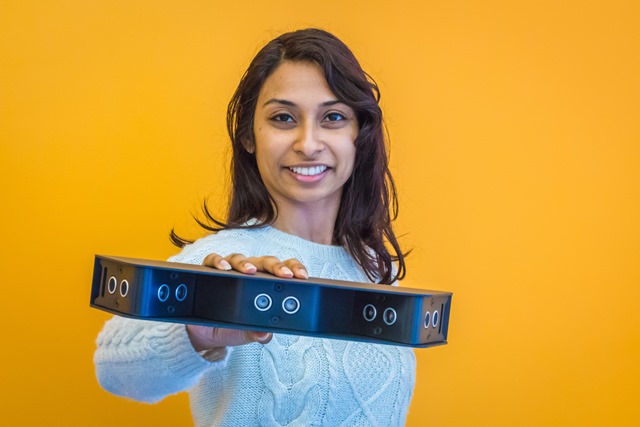
By Margaret Polanyi and Annie Atkinson
A Toronto team has created an add-on system that can transform a regular wheelchair into a “smart” wheelchair able to help prevent collisions.
The novel system uses sensors to detect obstacles and provides visual, audio or vibration feedback to drivers. It can be added to any powered or manual wheelchair.
“Rear visibility and manoeuvering in tight spaces are real issues with mobility devices―and collisions can result,” says Dr. Pooja Viswanathan, CEO of Braze Mobility Inc., the startup that commercialized the system. “Our obstacle-detection system is designed to increase safety, independence and quality of life for people living with mobility impairment.”
Two versions of the product―the Braze Hydra and Braze Sentina―debuted recently at the AGE-WELL Annual Conference in Winnipeg, Manitoba. AGE-WELL, Canada’s Technology and Aging Network, has supported Braze through its Strategic Investment Program.
Incorporated in 2016, Braze has also received support from the Ontario Brain Institute through their ONtrepreneurs program, the Ontario Centres of Excellence, the National Research Council of Canada Industrial Research Assistance Program (NRC IRAP), the Impact Centre at the University of Toronto (U of T) and Semaphore Research Cluster at U of T.

Herman Witlox, a powered wheelchair user who helped to Beta test the obstacle-detection system, calls it “a lifesaver” that helps him avoid collisions with people and property that can happen when changing directions or backing up, for example.
“It gives you an awareness and a sense of security,” says Witlox, who has continued to use the system and is involved with a company that will be one of its distributors.
The system can now be ordered at www.brazemobility.com by institutions such as hospitals, long-term care facilities and seating clinics, and by individual consumers, across North America.
For Dr. Viswanathan, a postdoctoral fellow in computer science at the University of Toronto and an AGE-WELL highly qualified personnel (HQP), the launch of the new system is a personal milestone. She has worked for over a decade on collision-avoidance systems for wheelchairs.
“Anyone who uses a wheelchair can benefit from this system, which will be particularly useful for people with low peripheral vision and limited neck and upper body flexibility” she says. “One of our testers says he feels like he has eyes on the back of his head with this technology. He says that it’s ‘got his back.’
“And for people who are excluded from using powered wheelchairs, including some older adults with dementia, the system will widen access to mobility devices, giving new opportunities for independent mobility,” says Dr. Viswanathan, who co-founded Braze Mobility with Dr. Alex Mihailidis, a Toronto Rehab/University of Toronto scientist and scientific director at AGE-WELL.
Braze is generating jobs as well as products. Nine people are involved with the company, including contractors and interns. Graham Browning, a recent engineering graduate from Ontario’s University of Waterloo, is now a product manager. He took the position at Braze over other offers.
“A big motivating factor was wanting to make a positive impact in people’s lives,” he says.
Braze has earned recognition at several recent pitch competitions. The company captured cash prizes after coming first in the POWER PLAY pitch competition (hosted by Toronto Rehab Foundation, in partnership with the iDAPT Centre for Rehabilitation Research and AGE-WELL), the CNE Innovation Garage, and a competition hosted by the Ontario Bioscience Innovation Organization (OBIO).
Margaret Polanyi is Senior Communications Manager at AGE-WELL. Annie Atkinson is a freelance writer. AGE-WELL is a federally funded Network of Centres of Excellence that is harnessing the power of new technologies to benefit older adults and caregivers. The pan-Canadian network brings together researchers, industry, non-profits, government, care providers and end-users to develop solutions for healthy aging. For more information, visit https://agewell-nce.ca/

